
Israel's history in maps
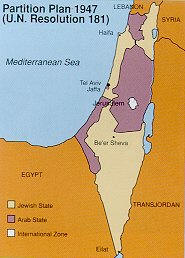 Partition Plan 1947 (UN Resolution 181):
Partition Plan 1947 (UN Resolution 181):
In 1947, Great Britain relinquished to the UN the power to make decisions relating to the status of the Land of Israel. The General Assembly appointed a special committee that collected evidence and decided unanimously that Israel should be granted independence.
On 14 May 1948 the State of Israel was proclaimed according to the UN partition plan (1947). Less than 24 hours later, the regular armies of Egypt, Jordan, Syria, Lebanon and Iraq invaded the country, forcing Israel to defend the sovereignty it had regained in its ancestral homeland.
In what became known as Israel's War of Independence, the newly formed, poorly equipped Israel Defense Forces (IDF) repulsed the invaders in fierce intermittent fighting, which lasted some 15 months and claimed over 6,000 Israeli lives (nearly one percent of the country's Jewish population at the time).
This Map Shows The 1948 Invasion Of Israel.
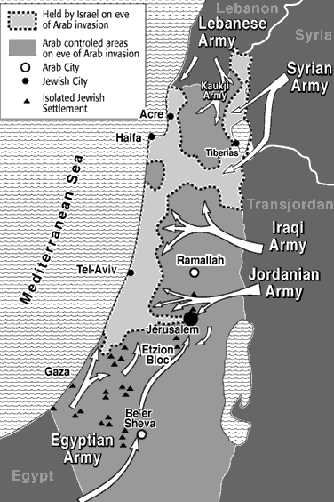 The 1948 Arab–Israeli War, known by Israelis as the War of Independence or War of Liberation and by the Arabs as the Catastrophe.
The 1948 Arab–Israeli War, known by Israelis as the War of Independence or War of Liberation and by the Arabs as the Catastrophe.
On 14 May 1948, David Ben-Gurion declared the independence of the state of Israel, and the 1948 Palestine war entered its second phase, with the intervention of several Arab states' armies the following day.
The war commenced upon the termination of the British Mandate of Palestine in mid-May 1948 following a previous phase of civil war in 1947–1948. After the Arab rejection of the 1947 United Nations Partition Plan for Palestine (UN General Assembly Resolution 181) that would have created an Arab state and a Jewish state side by side, five Arab states invaded the territory of the former British Mandate of Palestine.
Egypt, Iraq, Jordan, Lebanon and Syria attacked the state of Israel, leading to fighting mostly on the former territory of the British Mandate and for a short time also on the Sinai Peninsula and southern Lebanon.
The war concluded with the 1949 Armistice Agreements, but it did not mark the end of the Arab-Israeli conflict.(1)
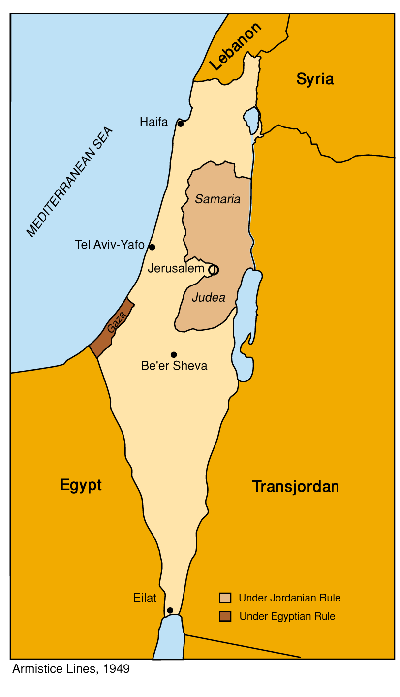 1949 - 1967 Armistice Lines:
1949 - 1967 Armistice Lines:
During the first few months of 1949, direct negotiations were conducted under UN auspices between Israel and each of the invading countries (except Iraq which has refused to negotiate with Israel to date), resulting in armistice agreements which reflected the situation at the end of the fighting.
Accordingly, the coastal plain, Galilee and the entire Negev were within Israel's sovereignty, Judea and Samaria (the West Bank) came under Jordanian rule, the Gaza Strip came under Egyptian administration, and the city of Jerusalem was divided, with Jordan controlling the eastern part, including the Old City, and Israel the western sector.
Sometimes the term "green line" is used instead of Armistice Line.
1956 Sinai Campaign Map:
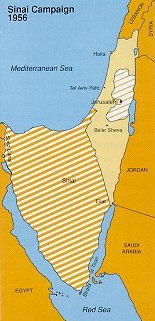 In the early 1950s, Egypt violated the terms of the Egyptian-Israeli armistice agreement and blocked Israeli ships from passing through the Suez Canal, a major international waterway. It also began to block traffic through the Straits of Tiran, a narrow passage of water linking the Israeli port of Eilat to the Red Sea. This action effectively cut off the port of Eilat -- Israel's sole outlet to the Red Sea and Indian Ocean. Closure of the Suez Canal and the Tiran Straits damaged Israel's trade with Asia, for it meant that foreign ships carrying goods bound for Israel and Israeli ships carrying goods bound for the Far East had to travel a long and costly circuitous route to the Atlantic and Israel's Mediterranean ports.
In the early 1950s, Egypt violated the terms of the Egyptian-Israeli armistice agreement and blocked Israeli ships from passing through the Suez Canal, a major international waterway. It also began to block traffic through the Straits of Tiran, a narrow passage of water linking the Israeli port of Eilat to the Red Sea. This action effectively cut off the port of Eilat -- Israel's sole outlet to the Red Sea and Indian Ocean. Closure of the Suez Canal and the Tiran Straits damaged Israel's trade with Asia, for it meant that foreign ships carrying goods bound for Israel and Israeli ships carrying goods bound for the Far East had to travel a long and costly circuitous route to the Atlantic and Israel's Mediterranean ports.
At the same time, Palestinian Arab fedayeen launched cross-border infiltrations and attacks on Israeli civilian centers and military outposts from Egypt, Jordan and Syria. Arab infiltration and Israeli retaliation became a regular pattern of Arab-Israeli relations. In July 1956, Egyptian President Gamal Abdel Nasser nationalized the Suez Canal, threatening British and French interests in oil supplies and western trade.
Their interests converging, Israel, Britain and France planned an attack on Egypt, with the former seeking free navigation through international waters and an end to terrorist attacks and the latter two hoping to seize control of the Suez Canal.
On October 29, 1956, Israel began its assault on Egyptian military positions, capturing the whole of the Gaza Strip and the Sinai Peninsula. On October 31, France and Britain joined the fray and hostilities ended on November 5.(2)
Map Of 1967 Six Day War:
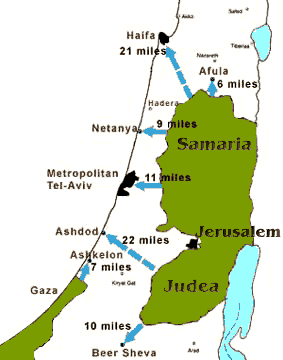 The Six-Day War of June 5–10, 1967 was a war between Israel and the neighboring states of Egypt, Jordan, and Syria. The Arab states of Iraq, Saudi Arabia, Sudan, Tunisia, Morocco and Algeria also contributed troops and arms.
The Six-Day War of June 5–10, 1967 was a war between Israel and the neighboring states of Egypt, Jordan, and Syria. The Arab states of Iraq, Saudi Arabia, Sudan, Tunisia, Morocco and Algeria also contributed troops and arms.
On May 15, Israel's Independence Day, Egyptian troops began moving into the Sinai and massing near the Israeli border. By May 18, Syrian troops were prepared for battle along the Golan Heights.
At the war's end, Israel had gained control of the Sinai Peninsula, the Gaza Strip, the West Bank, East Jerusalem, and the Golan Heights.
The number of Israelis killed were 983, and 4,517 were wounded. 46 Israeli aircraft were also destroyed. 15 Israeli soldiers were captured. Over 9,800 Egyptian soldiers were listed as killed, wounded or missing in action.
Jordan lost 700 soldiers killed, with around 2,500 wounded. Syrian losses are unknown, but are lower than Jordanian casualties.(3)
This Is A Map Of The 1973 Yom Kippur War:
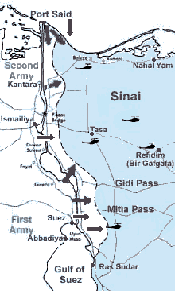
In an effort to force Israel to unilaterally surrender captured lands, Egypt and Syria jointly attacked Israel on October 6, 1973, on Yom Kippur, the holiest day of the Jewish calendar. Other Arab states contributed troops and financial support. Caught by surprise, Israel suffered severe losses in human life and equipment. Following an Egyptian refusal to accept a cease-fire and a Soviet airlift to the Arab states, the U.S. sent an airlift to Israel enabling her to recover from earlier setbacks. Saudi Arabia then led the Arab world in an oil embargo imposed on the United States and other western nations.
In the years following the 1973 war, Israel's enemies realized that they could not defeat Israel on the battlefield. They turned therefore to diplomatic warfare and sought to weaken Israel's international diplomatic position. Due to pressure from the Arab world, most African and third world countries broke diplomatic relations with Israel.
In 1975, the Soviet-Arab-Third World bloc at the United Nations succeeded in passing the infamous "Zionism equals racism" General Assembly resolution which was an attempt to de-legitimize the right of the Jewish people to return to their ancestral homeland. The resolution was not revoked until December 1991. Following a cease-fire, the war officially ended on October 22, 1973.(4)
Other Sources That Offer Maps Of Interest Include:
- Focus On Jerusalem Ministries:
- Israels' Story In Maps (Israel Ministry Of Foreign Affairs - over 45 maps here):
Miscellaneous:
Other articles of interest include:
- A Brief History Of Israel's War
- A Lasting Peace
- Balfour Declaration 1917
- Conflict Dates And Agreements
- Gaza Strip Timeline
- Israel's Nuclear Program
- Jerusalem's History
- 20 Facts About Israel And The Middle East
- Maps
- Israel's War Of Independence 1948
- Israel's Sinai Suez War Oct. - Nov. 1956
- Israel's Six Day War 1967
- Israel's War Of Attrition 1967 - 1970
- Israel's Yom Kippur War Oct. 1973
- 1987 Intifada
- 2000 Intifada (Al-Aqsa)
PALESTINIAN RESISTANCE AND THE PALESTINIAN LIBERATION ORGANIZATION (PLO)
- PALESTINIAN RESISTANCE AGAINST ISRAEL
- Palestinian Liberation Organization
- Factions of the Palestinian Liberation Organization
- Palestinian Liberation Organization, Bureaucracy and Money
- Palestinian Liberation Organization in Jordan
- Palestinian Liberation Organization in Lebanon
- Palestinian Liberation Organization in Tunisia
PALESTINIAN RESISTANCE AGAINST ISRAEL
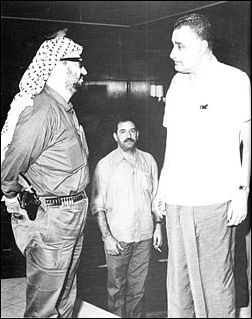
Arafat, Nasser and Abu Jihad
at Arab conference Palestinians began becoming more politically active in the wake of the Arab nationalist movement in the 1950s. As the effort to strengthen Israel grew so too did anti-Israeli sentiments among Arabs and Palestinians. The Palestinian refugee camps in particular became breeding grounds for political activism and resistance against the Israelis.
One Palestinian refugee told the Los Angeles Times he vowed to fight the Israelis after he witnessed Israeli soldiers beating up some Palestinian old men after some children poked holes in sandbags set up at an Israeli position. “This gave me a green light to try to be free of the occupation. I will never forget the fear, my father, my mother and I felt.".I had the right to refuse my occupier." He began his career as a resister by writing anti-occupation slogans on walls. He then made contact with the PLO and began running weapons. He was arrested and placed in an Israeli prison and his family's house was dynamited after he threw a grenade into a truck filled with Israeli soldiers.
Many Palestinians have immediate family members or relatives who have participated in one way or another in the resistance against Israelis. Some have joined terrorist organizations. Others participated in the intifadeh. Some have been killed by Israeli soldiers. Many have been jailed. "Graduate school" is slang for Israeli prisons. Others have been deported or prevented from entering the country.
Book: War Without End: Israelis, Palestinians and the Struggle for a Promised Land by Anton La Guardia (Thomas Dunne
Palestinian Liberation Organization

Six Day War The Palestinian Liberation Organization (PLO) was established in 1964 by Egyptian President Gamal Abdel Nasser as a front for Egyptian activities in Israel. After the Six-Day War, Palestinians began facing the reality that the Arab nations had done and could little to help them so they began forming their own political groups and increasingly began using the PLO as rallying point for their efforts.
After the Six-Day War, a number of militant Palestinian groups became active. One of these was Fatah (who name is a reverse acronym in Arabic for “Palestine Liberation Movement”). It was founded in 1958 in Kuwait by three young Palestinian expatriates, including a building contractor named Yasser Arafat.
The purpose of the PLO was not to defeat the Israelis or even weaken them but rather to draw attention to the Palestinian cause through publicity---a kind of psychological victory. This idea become more relevant after the Arab armies were defeated in the Six-Day War in 1967 when conventual military tactics didn't work and other methods were needed. Terrorism (attacking civilian targets) was chosen in part because Israeli military installations were so well guarded and civilian target were much easier to hit.
In the years following the Six-Day War, Fatah and other activist groups---including ones amde up of social democrats and Marxist revolutionaries---took over the PLO. Thousands joined the PLO after an Israeli attack on a PLO base in Jordan on March 1968. Arafat became its leader in 1969. He is credited with transforming the PLO from a forum for the established Arab powers to a voice for the Palestinians, many of them in refugee camps scattered throughout the Middle East.
The PLO made a name for itself as a terrorist organization but has not been directly linked with terrorist violence for over two decaes. In 1988, Yasser Arafat declared a Palestinian state, renounced terrorism and recognized Israel. No Israeli has been killed by them since 1992.
Factions of the Palestinian Liberation Organization
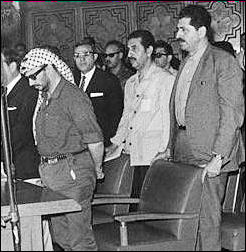
Hassan, Arafat at PNC The PLO was made up of a number of factions. Most of the these had their roots in Arab nationalist movements of the 1950s and early 1960s. Fatah, headed by Arafat, was the largest PLO faction. It had traditionally been regarded as more moderate than other groups. It was not Islamic or Marxist-Leninist. Its primary goal was establishing a Palestinian state.
The Front for the Liberation of Palestine (PFLP), headed by Abu Ali Mustafa, was the second largest faction of the PLO. Founded by Arab intellectuals and a handful of Palestines, it was a Marxist-Leninist revolutionary group and supporter of terrorism. Mustafa was killed by an Israeli missile in August 2001.
The Black September group, an arm of the PLO fled to Lebanon in 1970, and there launched their terrorist campaign, include the Munich attack. It is widely believed that Black September operated under Arafat's control.
Other PLO groups included the Democratic Front for the Liberation of Palestine, Vengeance Youth and the Heroes of the Return. Non-PLO Palestinian groups were not tolerated by the PLO. One PLO official went as far as threatening to kill any Palestinian who dared to represent the Palestinians without PLO approval.
Palestinian Liberation Organization, Bureaucracy and Money
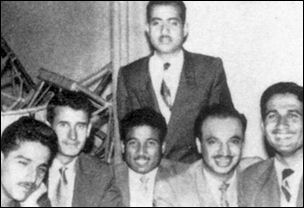
Arafat as an engineering student By the 1990s the PLO had become a semi-government providing social benefits and limited government services for Palestinian refugees and Palestinians in territories occupied by Israelis. In the early 1990s the PLO had a $200 million annual budget and $5 billion in reserves and a quasi civil service that had as many as 28,000 employees around the world.
The PLO received about $500 million a year in donations, mainly from oil-rich Arab nations and rich sympathizers. It staged a number of terrorist attacks to bring international attention the plight of the Palestinian people. The international response to the PLO activities was mainly disgust and revulsion.
For decades Israel refused to negotiate with the PLO until it recognized Israel's right to exist. Israel often pushed for friendly relations with non-PLO Palestinians and even embraced Hamas for a while.
When Palestine gained limited self rule the PLO became the Palestinian Authority, the government of the Palestinians.
Palestinian Liberation Organization in Jordan
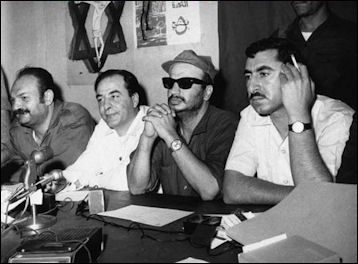
Arafat in Jordan The PLO ( Palestinian Liberation Organization) used Jordan as a base of operation for attacks against Israel between 1967 and 1970. The PLO guerillas were known as fedayeen in Arabic. During that time, Fatah and number of other activists---including social democrats and Marxist revolutionaries---took over the PLO and set up a virtual state-within-a-state in Jordan.
The PLO and the Jordanian government were not particularly friendly. The first PLO guerilla to be killed was shot by the Jordanian army not the Israelis. The government of King Hussein became increasingly aggravated with PLO as they used Jordan for a staging area for raids into Israel, promoting numerous Israeli counter raids and retaliatory strikes in Jordan.
The PLO tried to take advantage of a weak government in Jordan and take control of Jordan. The move resulted in civil war in Jordan in September 1970. King Hussein moved to crush the PLO while the PLO attempted to oust the king. The PLO assumed that the large population of Palestinian refugees in Jordan would rally to their support, and tip the balance in their favor. The PLO guessed wrong. Although there were a few defections, the Jordanian army remained loyal to the King.
King Hussein's Bedouin army, armed with U.S. support and weapons, put down the rebellion and napalmed and staffed Palestinian refugee camps. Many innocent people got caught in the middle of the fighting. Perhaps thousands of civilians died. Many Palestinians hated King Hussein as a result of the conflict and many members of the Jordanian army hated the Palestinians. During the fighting Israel amassed troops on border to show support for Hussein.
The fighting came to an end after a cease-fire was brokered at an Arab summit in Cairo and announced on September 27, 1970. The Red Cross estimated that 3,000 people were killed. The Jordanians said the figure was much lower. Arafat was smuggled out of Jordan disguised as a Kuwaiti official and most of the PLO fighters were forced to move to Lebanon. Many Palestinians remained in Jordan but their numbers were greatly reduced and their activities were strictly controlled by the government.
Palestinian Liberation Organization in Lebanon

Arafat in Lebanon Thousands of Palestinians fled to refugee camps in Lebanon in the late 1960s to escape the civil war in Jordan and fighting in Israel. Some 400,000 Palestinian refugees sought refuge at camps in Lebanon. After a cease-fire was brokered between the PLO and Jordan at an Arab summit in Cairo on September 1970, the most PLO fighters moved to Lebanon, where the PLO helped to destabilize the country and push it towards civil war. The PLO set up its headquarters in West Beirut. They used the rugged country in southern Lebanon to launch attacks on Israel.
The PLO launched a state within a state in southern Lebanon in 1969 that operated until the Palestinians were thrown out of Lebanon in 1982. The PLO ran schools that increased the literacy rate of Palestinian children and took over the duties of a government: collecting garbage, delivering mail, and running a police force, prisons and criminal courts. It established a “revolutionary penal code, and providing flour and food not only for Palestinian but also for Lebanese. Arafat greeted world leaders in Beirut and top PLO officials were well paid.
Arafat was at the pinnacle of his career in the 1970s and early 1980s, when the PLO was based in Lebanon. He was not only the leader of the Palestinians but was also the most powerful man in war torn Lebanon. At that time he headed a 20,000 guerilla force and controlled the Muslim parts of Lebanon, which covered 40 percent of the country.
The PLO had a mixed record governing Lebanon. Poor living conditions persisted in slums and refugee camps and corruption was rampant. PLO leaders lived in luxury apartments, drove around in $150,000 bulletproof limousines and hosted parties with caviar while food and gasoline shortages occurred and uncollected garbage rotted in heaps as workers refused to show up for work. Under the PLO schools become hotbeds for radicalism, and a lack of government control helped push Lebanon into civil war.
The PLO staged raids and conducted shelling attack at targets in Israel, which prompted Israel to launch counterattacks into Lebanon. In 1982 after Israel invaded Lebanon for a second time in part to attack and quiet PLO strongholds in southern Lebanon that were bases for attacks on Israel the PLO was forced to leave Lebanon.
Palestinian Liberation Organization in Tunisia

Bill Clinton, Yitzhak Rabin and Arafat
at the White House in 1993 After Lebanon the PLO was primarily based in Tunis, Tunisia. From Tunis Arafat both directed the intifadeh and sent dispatched envoys around the globe to express his willingness to make peace wih Israel. In the process he won United States recognition but alienated many of his staunchest supporters.
Arafat played all sides. He maintained a relationship with the CIA while courting the KGB and Soviets during his struggle in the 1970s and 80s against Israel. In 1988 he accepted Israel's right to exist and renounced terrorism
Arafat and the PLO made the mistake of backing the Saddam Hussein during the Gulf War in 1990. Saudi Arabia and the Gulf states withdrew their financial support. The United States was angered. The Palestinians became isolated.
Arafat was inspired more by great revolutionaries and guerilla tactics than Muslim martyrs and radical Islam. He became more Islamic after radical Islamic came in vogue. His ability to endure was based on his charisma and his absolute control over PLO funds Although he was not directly tied to the terrorist activities of Palestinian groups in the 1970s and 80s and the suicide bombings of the 1990s and 2000s he is believed to ultimately have been behind many of the acts. Begin called him “that despicable guy with hair on his face."
Image Sources: Wikimedia Commons
Text Sources: New York Times, Washington Post, Los Angeles Times, Times of London, The Guardian, National Geographic, The New Yorker, Time, Newsweek, Reuters, AP, AFP, Wall Street Journal, The Atlantic Monthly, The Economist, Global Viewpoint (Christian Science Monitor), Foreign Policy, Wikipedia, BBC, CNN, NBC News, Fox News and various books and other publications.

No comments:
Post a Comment